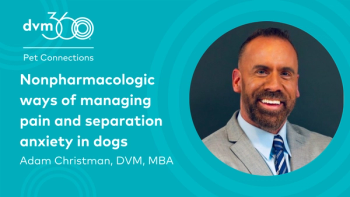
- dvm360 May 2021
- Volume 55
Cash is king: Tips to elevate your practice’s cash flow
When the going gets tough and the money gets tight, focus on cash flow and crack down on additional spending.
Lack of cash is usually the primary reason businesses fail. While veterinary practices have generally weathered the pandemic and the related recession well, there’s a cautionary tale here for the future. Focusing on cash flow management may not be the first priority on a practice’s to-do list right now, it needs to be on the “lessons learned” list for the future.
What is cash flow?
The definition of cash flow is simple: Cash inflows are any cash received by the business, whereas cash outflows are any cash expenditures made by the practice. Net cash flow is the positive or negative amount left over, once you subtract the cash expenditures from the cash inflows.
Unfortunately, it is rare for a practice to prepare or review true cash flow reports regularly. Most tend to use a profit and loss statement (P&L) for management purposes. However, even when prepared on a cash basis, this document does not include all the items necessary to analyze cash flow. Cash inflows and outflows that are not incorporated in a P&L include loan proceeds, the principal portion of loan payments, owner dividend payments, and purchases of equipment made with cash. A P&L also includes several noncash items, such as amortization and depreciation, neither of which should be part of the calculation of cash flow.
It is possible for a practice to have a high level of taxable income or practice profitability but very low cash flow. This generally occurs when the clinic is using profits or taxable income to make debt payments, buy equipment, or distribute money to owners.
Ongoing cash flow analysis
Knowing how much cash is in the bank isn’t enough. The management team should also know where the cash comes from, where it goes, and what the expected cash position will be 3 to 6 months from now. The most important report required to manage cash flow effectively is a monthly cash flow statement because it shows actual cash inflows, cash outflows, and net change in cash for the period. A cash flow budget and regular comparisons between actual cash flow and budgeted cash flow are also useful for forecasting cash inflows and outflows.
Building and maintaining cash reserves
All types of business, including veterinary practices, need a cash reserve to meet unexpected expenditures and carry them through bad times. This reserve can come from a combination of actual cash saved in the bank and a line of credit or similar instrument. Relying solely on a line of credit is risky, as lending terms may change or the line of credit may not cover the entire amount needed. Maintaining a separate bank account will reduce the temptation to draw on this cash.
If you don’t have a reserve account, start building one now. If you do, review it to see if it needs to be increased. Regular deposits should be made into the reserve account until it is at a level that is comfortable for the management team.
How much should that be? It is commonly recommended that an emergency fund should cover 3 to 6 months of fixed expenses. Where in that range a practice chooses to aim depends on the practice owner’s risk tolerance, local and national business, economic trends impacting the practice, how much the practice revenue is expected to drop, the amount of debt the practice has, and the practice’s ability to cut expenses if needed.
Improving cash flow
There are numerous ways to improve your cash flow. Start by focusing on what will give you the biggest bang for your buck. If your practice reaches a point where there are too many open appointment slots, then focus on increasing revenue through improved marketing, expanded hours, or offering a better client service experience.
Tighten up practice spending
One way to tighten up practice spending is by postponing major expenditures such as remodeling or large equipment purchases. Another is
Take a hard look at your staff and payroll
This is the hardest decision most practice owners and managers will have to make (and usually one of the last). Review workflow and staff skills. Can you improve efficiency so you can see more patients without hiring more team members? If you have to reduce jobs or hours, involve the team in the discussion. Perhaps 1 team member could take a temporary leave of absence. Or, everyone may be willing to cut their hours back or withdraw from receiving raises to preserve jobs for all.
Although focusing on the big expenses is a solid place to start, don’t forget to review and eliminate other additional spending. The money you save from reducing expenses can be put toward more critical expenses or into an emergency fund.
Get paid for services on time
Do everything in your power to get paid at the time services are provided. Don’t become the bank. You and your staff should work toward educating your clients about third-party payment options as well as the benefits of
Every practice has tough times. When cash flow is tight, stay proactive to help keep your practice afloat. If you’re are not currently experiencing issues with cash flow, my hope is that the above tips will better prepare you for if and when you do.
Karen E. Felsted, DVM, MS, CPA, CVPM, CVA, has spent the past 15 years working as a financial and operational consultant to veterinary practices and the animal health industry. She also spent 3 years as CEO of the National Commission on Veterinary Economic Issues. She has written many articles for a wide range of veterinary publications and speaks regularly at national and international veterinary meetings.
Articles in this issue
over 4 years ago
Respiratory disease: Pair up for protectionover 4 years ago
PIMS for corporate practicesover 4 years ago
Reader feedback: The nuances of veterinary practice valuationover 4 years ago
Why so much whiteness in the veterinary profession?over 4 years ago
May is Mental Health Month: Let the healing beginover 4 years ago
A closer look at veterinary unionsover 4 years ago
From new grad to veterinary practice ownerover 4 years ago
Tips for managing diabetes in dogs and catsover 4 years ago
Setting, monitoring, and achieving KPIs in veterinary practiceover 4 years ago
Upping your lateral suture gameNewsletter
From exam room tips to practice management insights, get trusted veterinary news delivered straight to your inbox—subscribe to dvm360.




